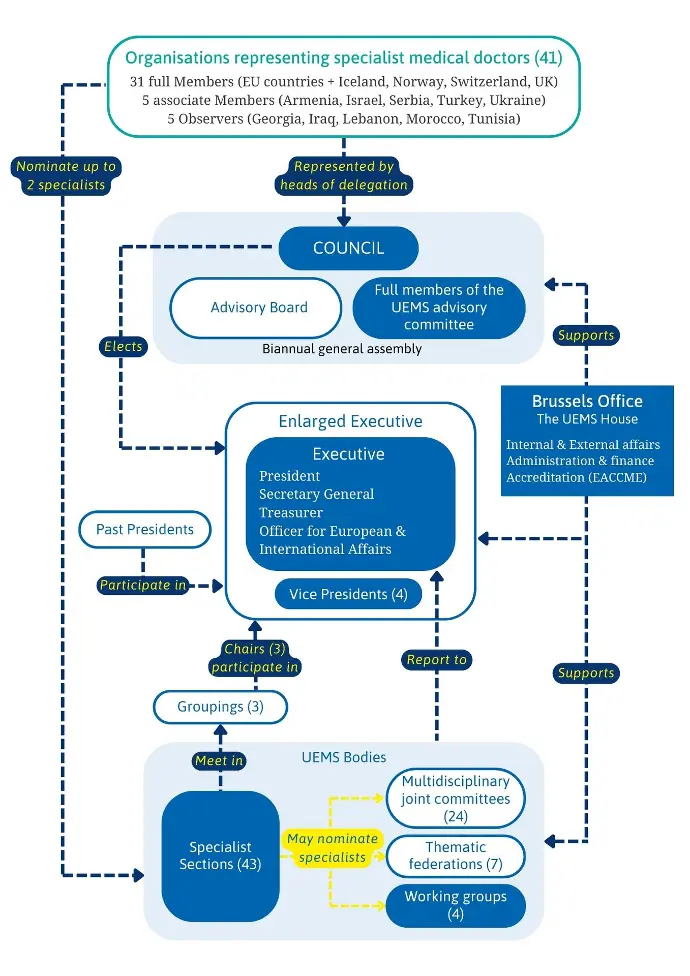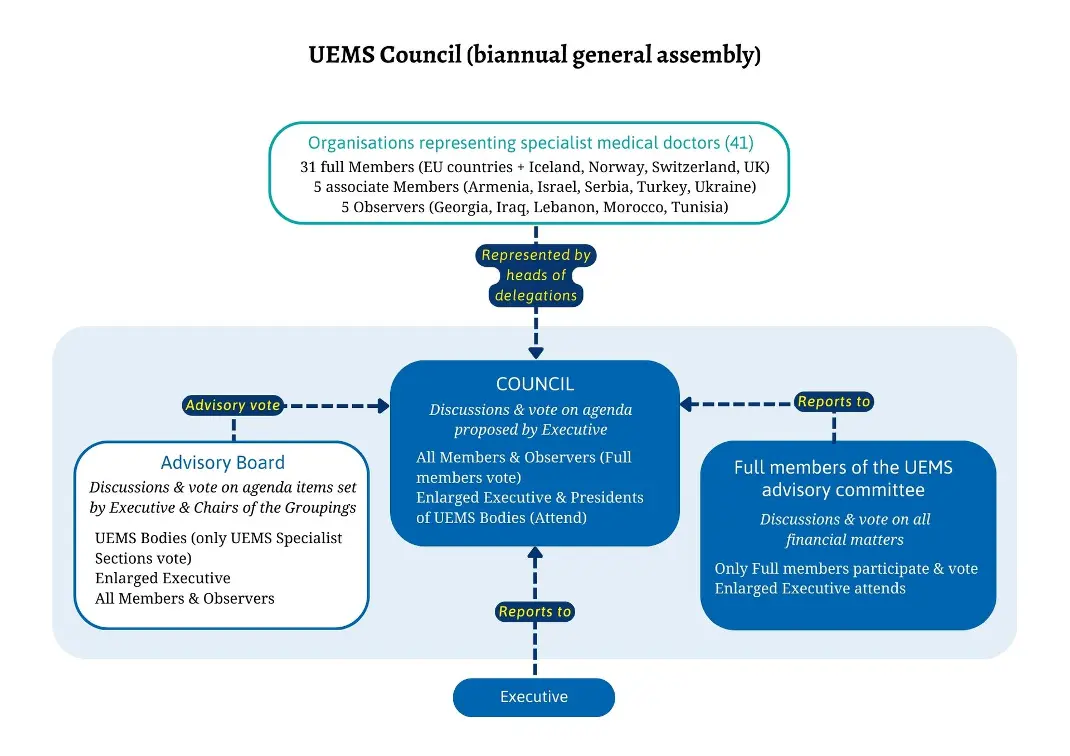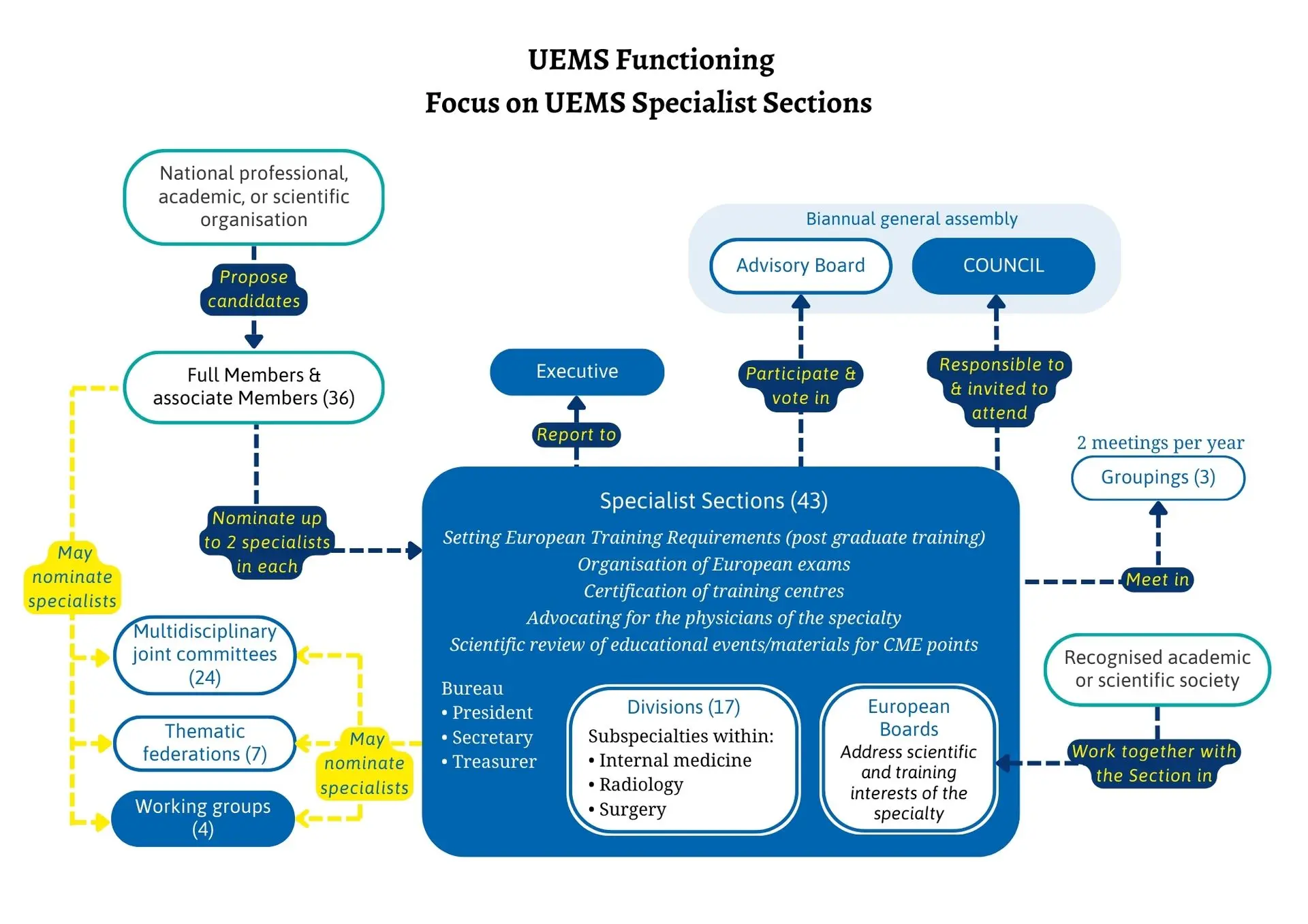Structure of the UEMS
General structure
The UEMS gathers individuals dedicated to promoting high standards of medical training, practice, and patient care across Europe.
The structure of the UEMS is complex, and detailed below. Diagrams for details on the functioning of our organisation can be downloaded:
UEMS Council
The members of the UEMS gather and meet twice a year in a general assembly, named the UEMS Council. The UEMS Council is the forum where representatives of all UEMS members, of UEMS bodies, and of have the opportunity to exchange views on the projects endeavoured by the UEMS, and of other European medical organisations
The orientation of UEMS, launch of projects and follow-up are discussed and decided at the occasion of the UEMS Council.
For the day-to-day functioning and activities, the structure of the UEMS is quite complex, with many bodies which have their own activities. It consists of:
Executive Committee
(Enlarged Executive Committee)
The Executive Committe has in charge the day-to day management of the organisation, and the coordination among UEMS bodies, in accordance with decisions taken at the UEMS Council.
Specialist Sections promote and support the interest of the different medical specialties at the European level, 3 Sections have subspecialties Divisions
Multidisciplinary joint committees work on medical common topics of interest
Thematic Federations work on transverse matters of interests for all medical specialists, such as their working conditions and notably on equality, diversity & inclusivity or sustainable medical practice
Working groups focus on issues of interest for medical specialists at European level, such as CME/CPD or PGT.
There also exist Advisory board working groups which work on internal matters of the UEMS.
Specialties Bodies
The UEMS represents more than 50 medical disciplines through:
- Specialist Sections,
- Specialist Divisions, and
- Multidisciplinary Joint Committees.
Main missions & activities
Set European Training Requirements (post-graduate training),
Organise European exams,
Assess and certify training centres,
Advocate for the physicians of their specialty,
Realise the scientific review of educational events/materials for CME points.
Specialties Sections (and their Divisions)
The most important medical specialties bodies within the UEMS are the 43 Specialist Sections, which represent the medical specialties recognised by the European Union.
They represent and promote their respective medical specialty, and develop European standards of medical training in their respective medical disciplines.
Indeed, the UEMS created in 1962 Specialist Sections for each of the main disciplines practised in the 6 common market member states. These groups of experts, made up of representatives of the national associations of the specialties concerned, carry out a considerable workload with the idea of coordinating and harmonising specialist training and criteria for the recognition of medical specialists.
UEMS Sections may set up European Boards which are working groups dedicated to address scientific and training interests of the medical specialty.
In this respect, European Boards welcome members of recognised academic or scientific society of the specialty in question.
Divisions & working groups
A UEMS Specialist Section may create one or more division(s) or working group under its responsibility, devoted to the study, promotion and defence of a branch of the specialty or competence.
Here below are all the UEMS Specialist Sections (and their Divisions, if any):
Child and adolescent psychiatry
Reproductive medicine (division)
Angiology/Vascular medicine (division)
Laboratory medicine / Medical biopathology
Oral and Maxillo-facial surgery
Physical and rehabilitation medicine
Plastic, reconstructive & aesthetic surgery
Interventional radiology (division)
Radiation oncology & radiotherapy
Abdominal wall surgery (working group)
Emergency surgery (division)
Endocrine surgery (division)
Hepato-pancreato-biliary surgery (division)
Minimally invasive surgery (working group)
Surgical oncology (division)
Transplant coordination (board)
Transplant immunology (board)
Transplant medicine (board)
Transplant surgery (division)
Multidisciplinary Joint Committees
The Multidisciplinary Joint Committees (MJC) of the UEMS group different Specialist Sections to work on common topics of interest, for competences or spheres of activity belonging to several disciplines..
They can have the same range of activities as the Specialties Sections, but on a medical discipline involving several specialties. The MJC may also set European Boards with the same functions & activities as the European Boards of a Specialty Section.
Here is the list of the medical disciplines created for these purposes:
Thematic bodies
Thematic Federations
UEMS Thematic Federations are platforms fo co-operation between Specialist Sections to address multidisciplinary issues.
Here are the UEMS Thematic Federations:
Working Groups
UEMS Working groups
They gather people to work on issues of interest for medical specialists at European level. We currently have the following Working groups:
- CME/CPD (Continuing Medical Education/Continuing Professional Development)
- PostGraduate Training
- AI
- Ukraine
Advisory board working groups
The UEMS has set Advisory Board Working groups which work on transverse internal topics of interest:
- Finances
- Promoting EACCME
- Linking national scientific societies to UEMS bodies
- Quality indicators
- Common projects


